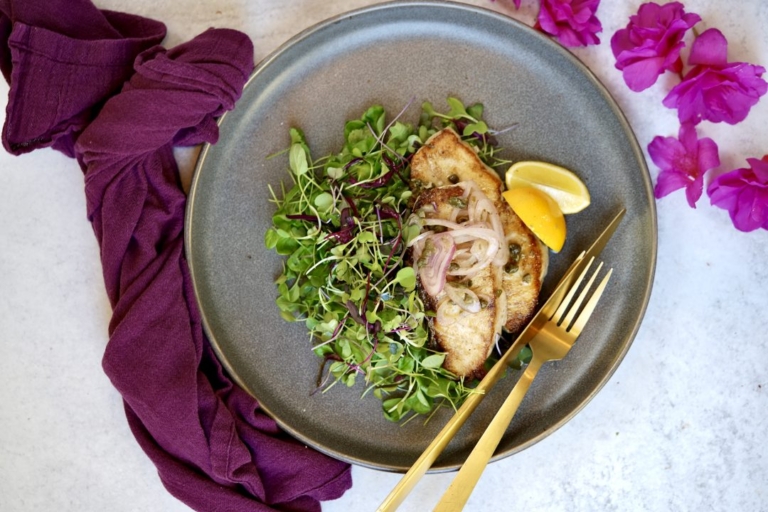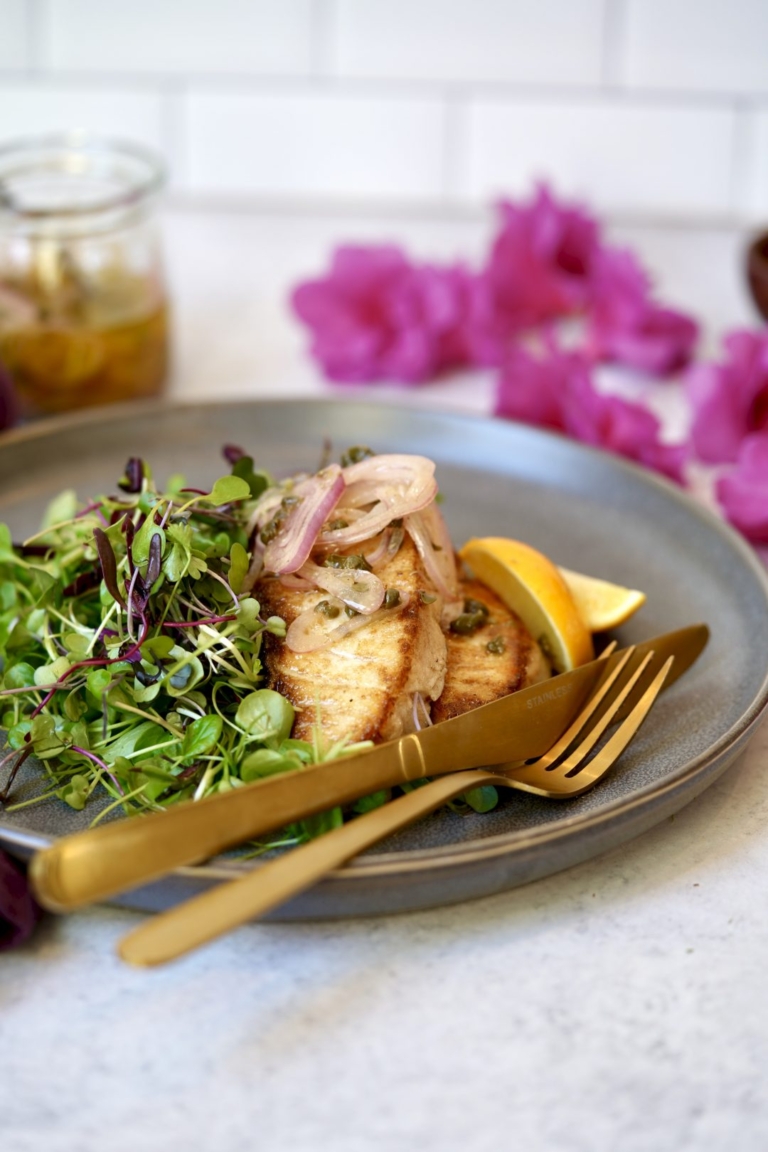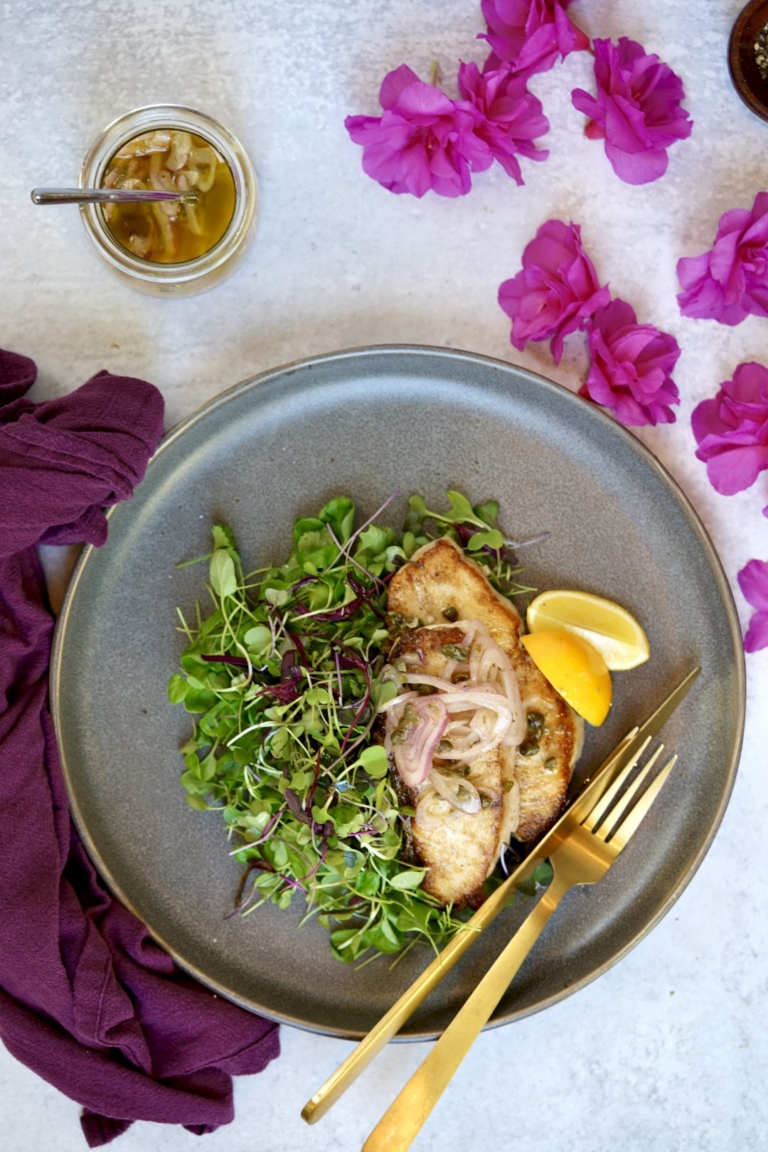
Seared Sea Bass With Shallot Vinaigrette
Summer is all about easy, often healthy(er) recipes and limited prep time. In warmer months most of us naturally gravitate to lighter meals with more fresh vegetables and often less carbs. I aspire to cook like this as much as possible, year-round because I honestly feel better, health-wise, doing so. But truthfully, this is easier said than done. So my motto is; do what you can, when you can—it does not have to be all or nothing. This seared sea bass with shallot vinaigrette, served with fresh greens, is a lovely, easy, go-to recipe for me in warmer months. The flaky, white fish sears up in minutes and is dressed with a subtle, yet flavorful, shallot dressing with salty capers.
Sustainability
When it comes to fish, sustainability matters. Research is always a good thing; downloadable buying charts, such as my go-to Monterey Bay Aquarium, are extremely accurate, but can also be a bit overwhelming. If you don’t use these types of tools, that’s fine, but know what your options are. Here are five great-tasting, sustainable fish, that you can always buy and eat without worry. In addition to these fish being plentiful, wild, and sustainably caught, they also tend to have lower levels of mercury as well.
- STRIPED BASS: A delicate, flavor similar to a snapper but cleaner and less oily. Its soft texture makes it well-suited for sautéing, roasting, or steaming. This fish does require a little attention when cooking because it can easily get overcooked. Striped bass pairs well with gentle flavors like leeks, shallots, and mushrooms, but can also hold up well with more assertive, spicy flavors.
- PACIFIC HALIBUT: With a subtle flavor and buttery texture, halibut is best when barely cooked through. If you overcook it, it will be very dry and flavorless. Halibut has a smooth texture that is slightly firm. Its subtle flavor should not be overpowered by aggressive sauces or marinades. Halibut pairs well with tarragon, chives, and any kind of green you can imagine.
- BLACK COD: Unlike the similarly textured Chilean sea bass, black cod is harvested from well-managed Alaskan fisheries, which impose strict catch limits to protect the species from depletion. Called sablefish in Europe, black cod is one of the richest-tasting fish around. It is buttery and luxurious and almost impossible to overcook. Black cod is extremely versatile and holds up well when steaming, braising, and roasting. This fish is wonderful with subtle preparations, but can also stand up to spicy, sauces and marinades.
- ARCTIC CHAR: Char is a distant cousin of salmon and trout. Char has a mild, salmon-like flavor and a beautiful pink color due to its natural diet, of tiny crustaceans, such as pink shrimp. You can cook char in numerous ways as it’s very hard to overcook because of its fatty texture which keeps it moist. Char can pair well with numerous flavors but goes exceptionally well with mushrooms, leeks, and fennel.
- ATLANTIC MACKEREL: This is a fish with a strong, robust flavor. The best way to cook mackerel is to sauté or roast it, as it is considered too oily for poaching or steaming. Mackerel’s assertiveness pairs very well with complex ingredients such as miso, soy, and citrus as well as flavorful vinaigrettes.
This healthy recipe is also easily adaptable and can be made with several types of fish. So, if you can’t find sea bass, go ahead and try it with halibut or black cod. And if you are looking for a a great starch to serve alongside it for a heartier meal, I strongly suggest my crispy leaf potatoes or my lentils and rice which are always big hits in my house.
Seared Sea Bass With Shallot Vinaigrette
Ingredients:
- 3 shallots, sliced into rings
- 1/2 cup, plus 3 tablespoons, Extra Virgin olive oil, divided
- 2 tablespoons capers, roughly chopped
- 1 tablespoon red wine vinegar
- Kosher salt and black pepper, to taste
- Four (6-ounce) pieces of striped bass or halibut
- 4 cups mixed greens or micro greens of your choosing
Directions:
- In a saucepan, add the shallots and 1/2 cup of olive oil, place over medium heat, and simmer the shallots until they are light golden brown, about 10-12 minutes.
- Transfer the shallots to a bowl and add the capers, vinegar, and about 1/4 teaspoon each of salt and pepper. Taste and adjust the seasoning as needed. Set aside.
- In a large skillet, add 1 tablespoon of the oil and heat over medium-high heat. Season the fish with salt and pepper. When the oil is hot, but not smoking, and the fish and sear until opaque, about 4 minutes per side. Divide among plates.
- Serve the sea bass with greens and the shallot vinaigrette drizzled over the top of the greens and fish.




